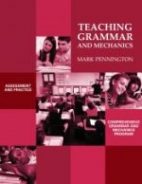Why Johnny Can’t Use Good Grammar
Some years back, the principal walked into my room while my student teacher was delivering a lesson. After a few minutes, the principal signaled me to step outside. “I would never hire Johnny to work at my school,” he said. Shocked, I asked him why. “On the board, he has a misplaced comma, and he ended a sentence with a preposition.” Sounds quite harsh, doesn’t it? That principal certainly had high expectations of his teachers.
Not every educated adult places the same level of importance regarding the proper use of grammar and mechanics as does that principal. However, many do. Proper grammar is a critically important tool for success in school, work, and life. We are judged, sometimes quite severely, by the words we use and the way we use them in both our speaking and writing. Misused grammar betrays us. The way we talk and write reflects our background, education, and ability to communicate. So what are the myths and realities of grammar instruction and most importantly, how can we improve student grammar?
The Five Myths of Grammar Instruction
1. Grammar is acquired naturally; it does not need to be taught. Oral language is not always an efficient teacher. In fact, it can be quite a mixed bag. For every proper modeling of the pronoun in the sentence: It is I, students hear at least five models of the incorrect: It is me. Grammar as it is caught must be complemented by a grammar that is taught.
2. Grammar is a meaningless collection of rules-most of which don’t work half the time. This myth may have developed from mindless “drill and kill” grammatical exercises with no application to real writing. Actually, our English grammar is remarkably flexible and consistent.
3. Grammar cannot be learned by students with some learning styles or disabilities. While it may be true that students learn language differently, at different rates, and vary in proficiency, there has been no research to show that some students cannot learn grammar.
4. English grammar cannot be learned by second language learners. Some teachers think that students who speak other languages get confused between the primary language and English grammars. The research proves otherwise. Intuitively, many of us have significantly increased our own knowledge of English grammar by taking a foreign language.
5. Reading and writing a lot will improve grammar. Reading grammatically rich literature is wonderful, but learning is not passive and does not come by osmosis. Writing poorly may, indeed, reinforce poor grammatical usage.
How should we teach grammar to Johnny? Don’t waste time teaching Johnny what he already knows. Find out what he does not know and target these areas of grammatical deficits. Use a good diagnostic assessment. Have Johnny practice those weaknesses with specific skill worksheets.
Teach the language of grammar and recognition of the common grammatical structures. Johnny has to know what a prepositional phrase is and how to know one when he sees one. In fact, over 30% of academic writing is composed of this grammatical form. Maybe learning “Conjunction Junction, What’s Your Function” on Sesame Street® was not such a bad idea after all. Teach grammar in the context of writing. Using the common grammatical structures, have Johnny begin half of his written sentences with different sentence openers. This practice serves two purposes: It teaches recognition and manipulation of grammatical structures and it improves sentence variety.
*****
I’m Mark Pennington, author of the full-year interactive grammar notebooks, grammar literacy centers, and the traditional grade-level 4, 5, 6, 7, 8 and high school Teaching Grammar and Mechanics programs. Teaching Grammar and Mechanics includes 56 (64 for high school) interactive language conventions lessons, designed for twice-per-week direct instruction in the grade-level grammar, usage, and mechanics standards. The scripted lessons (perfect for the grammatically-challenged teacher) are formatted for classroom display. Standards review, definitions and examples, practice and error analysis, simple sentence diagrams, mentor texts with writing applications, and formative assessments are woven into every 25-minute lesson. The program also includes the Diagnostic Grammar, Usage, and Mechanics Assessments with corresponding worksheets to help students catch up, while they keep up with grade-level, standards-aligned instruction.
Or why not get the value-priced Grammar, Mechanics, Spelling, and Vocabulary (Teaching the Language Strand) grades 4, 5, 6, 7, and 8 BUNDLES? These grade-level programs include both teacher’s guide and student workbooks and are designed to help you teach all the Common Core Anchor Standards for Language. In addition to the Teaching Grammar and Mechanics program, each BUNDLE provides weekly spelling pattern tests and accompanying spelling sort worksheets (L.2), 56 language application opener worksheets (L.3), and 56 vocabulary worksheets with multiple-meaning words, Greek and Latin word parts, figures of speech, word relationships with context clue practice, connotations, and four square academic language practice (L.4, 5, and 6). Comprehensive biweekly unit tests measure recognition, understanding, and application of the grammar, mechanics, and vocabulary components.
The program also has the resources to meet the needs of diverse learners. Diagnostic grammar, usage, mechanics, and spelling assessments provide the data to enable teachers to individualize instruction with targeted worksheets. Each remedial worksheet (over 200 per program) includes independent practice and a brief formative assessment.
Check out the brief introductory video and enter DISCOUNT CODE 3716 at check-out for 10% off this value-priced program. We do sell print versions of the teacher’s guide and student workbooks. Contact mark@penningtonpublishing.com for pricing. Read what teachers are saying about this comprehensive program:
The most comprehensive and easy to teach grammar, mechanics, spelling, and vocabulary program. I’m teaching all of the grade-level standards and remediating previous grade-level standards. The no-prep and minimal correction design of this program really respects a teacher’s time. At last, I’m teaching an integrated program–not a hodge-podge collection of DOL grammar, spelling and vocabulary lists, and assorted worksheets. I see measurable progress with both my grade-level and intervention students. BTW… I love the scripted lessons!
─Julie Villenueve

